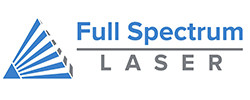
Laser Cutting: CO2
With CO2 Laser systems, their functionality can be narrowed down into two different areas: Cutting and Engraving. Whether you are laser cutting or engraving, it is very easy to keep your mind in a two dimensional way of thinking. This is understandable, especially when you consider that while engraving, if the laser head strays too far from that two dimensional plane, the results will diminish. But the amazing thing about CO2 laser cutting is that you can expand your ideas from a 2 dimensional workspace into a 3 dimensional reality.
Laser Cutting: Vector vs Raster
What is vector and how is it different from raster? These are the two terms that arise frequently when using your laser for cutting or engraving. The easiest way to understand the difference between these two terms is to understand the ways they are used. Raster is the term that is used when referring to things that you would like to have engraved onto the material, where the term Vector is used when you refer to continuous lines that are usually used by a laser for cutting.
Laser Cutting: Basic Vector Cut
With just one concept, laser cutters can create multiple outcomes with just minor design variations in design software. We start with a basic pattern, which was created in Adobe Illustrator as a vector file, saved as a PDF, and then imported into the RetinaEngrave v3.0 software (RE3). In the example below, the red lines tell the laser what to cut. All red lines will be cut through the material creating the empty space in the final project.

Please note, the color of the line will not determine how it cuts, but specifically the settings associated with that color in the software--colors are used for reference in these images.
Laser Cutting: Vector Marking
When you use a vector in your laser, it doesn’t always have to be used with cutting. Vector lines can be used to create fine lines and outlines which will add an extra depth to your design and give you a more definite way to mark something into your material. When you Raster (engrave) your material, the laser will lay your image down onto the material from top to bottom and line by line, the same way that a printer would print onto paper. But with vector marking, your laser is able to create contrasting and detailed lines onto your material. This can be used in combination with both cutting and engraving to give depth to your creation. All you have to do is to use lower power and higher speeds which will allow the laser to mark the material without actually cutting it.

Please note, the color of the line will not determine how it cuts, but specifically the settings associated with that color in the software--colors are used for reference in these images.
Laser Cutting: From Design to Software
When you are creating your images that you would like to be imported into the laser software like RE3, there are a few tips that will help save you a lot of time:
- Setting Stroke Thickness: The actual laser spot is only about 0.005 inches in diameter. So in other words, it is very small, so your lines will need to be very thin in order to properly import. To avoid having your laser make a double pass, or cut two lines, set your thickness of the vector line in your design software to the smallest “stroke” width possible. For example, this would be the “hairline” setting in Adobe Illustrator.
- Utilize Colors for organization: advanced software like RE3 has the ability to read different colors when you import your file from your design software. These colors will allow you to be able to sort your design and assign specific laser settings to different colors. So if you have a design that needs to utilize both vector marking and engraving, you can use these colors as a method to inform your laser what it needs to do as it gets to that point in the process. It is best to use a variety of colors to accomplish this that are different from each other (e.g. dark orange and red may be interpreted as the same color when imported in RE3).
- Save to PDF: PDFs are one of the best file types for importing into laser software. When your design software saves your vector file, the PDF will save all the information beyond just the physical image, which will give software like RE3 more information so it may accurately represent the design.

Example: Results of improper stroke thickness and getting double lines
These are things that are designed in our RE3 laser control software to make the process from design to using a laser for cutting as easy as possible. There are many design programs out there, and as you work with your favorite software alongside RE3, you’ll find your ideal workflow. The great news is that RE3 is installed on all Muse Series and P-Series lasers, meaning that if you grow into a larger laser, or expand into a different type of laser, you’ll be able to take what you learn with you.
So whether you are creating detailed crafts or if you are prototyping components for large scale production, laser cutting is a way for you to expand your capabilities for your personal projects as well as increase your return on investment by offering your customers a wider variety of customization options. Experiment with different methods of vector cutting and marking to see what works best for you and your projects.
Full Spectrum Laser is a leader in easy to use, highly versatile laser cutting and laser engraving machines. Our systems range in size from desktop units and high-volume machines through industrial-grade production equipment. Our machines are running all over the world: from grade schools to National Labs, garage startups and many Fortune 500 companies. Contact us today to learn more.

